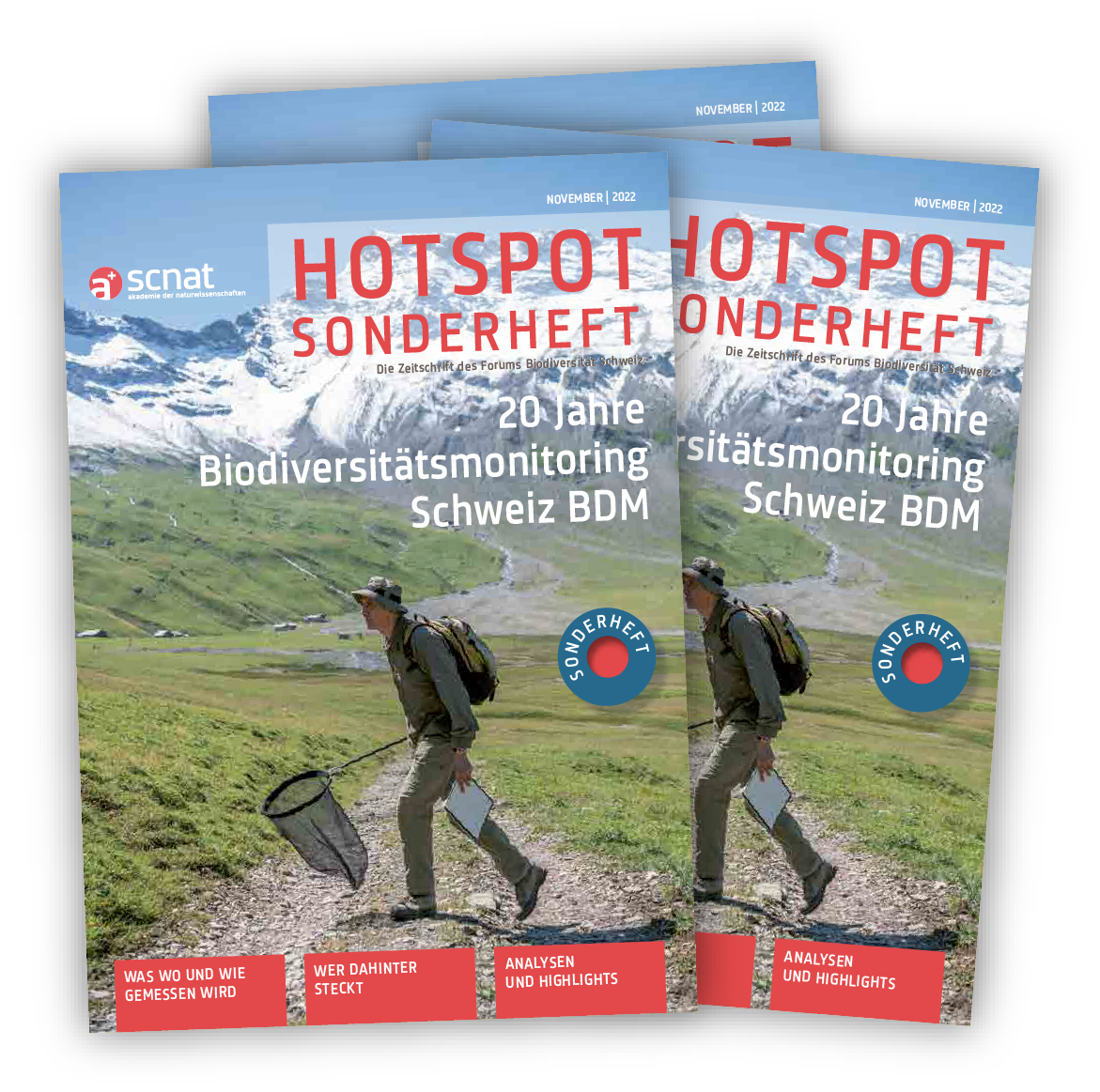List of scientific publications
Filter by Tag
Filter by Date
Accelerated global biodiversity loss critically threatens forest ecosystem multifunctionality and service provision. Understanding environmental drivers across taxonomic (TD), functional (FD), and phylogenetic (PD) biodiversity facets is essential for effective conservation.…
Die Studie dokumentiert gegenläufige Trends der alpha- und beta-Diversität in zehn aquatischen und terrestrischen Artengruppen der Schweiz. Während die alpha-Diversität in den aquatischen und terrestrischen Gruppen zunimmt, nimmt die beta-Diversität…
Concerns about intensification of land use and land abandonment threatening plant diversity called for the establishment of national monitoring and agri-environmental payment schemes in Switzerland. Yet, little is known about…
The negative effects of habitat loss on biodiversity are undisputed, while the effect of habitat configuration, i.e., the spatial arrangement of habitat area, has been debated for decades. To develop…
99 Schweizer Bäche wurden anhand der beiden Bioindikatoren Fische und Makrozoobenthos untersucht. Die Mehrzahl der Bäche zeigt wesentliche Defizite beim ökologischen Zustand. So fehlen beispielsweise in über 70% der Gewässer…
We need landscape-scale approaches to design and manage agro-ecosystems that can sustain both agricultural production and biodiversity conservation. In this study, yield figures provided by 299 farmers served to quantify…
Als Folge des Klimawandels etablieren sich immer mehr wärmeliebende Arten in Schweizer Gewässern. Da wirbellose Kleinlebewesen als Bioindikatoren für die Qualität von Fliessgewässern dienen, könnte diese Entwicklung die biologische Gewässerbeurteilung…
2024
Auswirkungen sichtbarer Veränderungen an Gewässermessstellen. Analyse von Makroinventebraten-Daten.
Die Gewässerstruktur und Wasserqualität der Schweizer Fliessgewässer sollen durch Bestimmungen des Gewässerschutzgesetzes verbessert werden. Langzeitdaten der beiden schweizweiten Monitoringprogramme NAWA und BDM zeigen, dass bereits gewisse Auswirkungen auf die Makroinvertebraten…
Pollution, climate change, and shrinking habitats are driving major changes in flowering plant and pollinator populations. These include shifts in local abundance, population extirpations, range shifts, altered community composition, and…
Forests are under pressure and going through rapid changes. However, current inventorying and monitoring (IM) programs are often either disjointed, too narrow in their scope and/or do not operate at…
Rising temperatures are leading to increased prevalence of warm-affinity species in ecosystems, known as thermophilisation. However, factors influencing variation in thermophilisation rates among taxa and ecosystems, particularly freshwater communities with…
We adopted a landscape-scale approach to analyze the genetic patterns (diversity, structure, and differentiation) of the Marbled White (Melanargia galathea). This butterfly species is characteristic of semi-dry grasslands, which have…
Reusser, J. E., Siegenthaler, M., Winkel, L. H. E., Wächter, D., Kretzschmar, R. & Meuli, R. G. (2023). Geochemischer Bodenatlas der Schweiz: Verteilung von 20 Elementen in den Oberböden. Agroscope…
2023
Thermophilisation of communities differs between land plant lineages, land use types and elevation
Bryophytes provide key ecosystem services at the global scale such as carbon storage and primary production in resource limited habitats, but compared to vascular plants knowledge on how these organisms…
PFAS (per- und polyfluorierte Alkylverbindungen) umfassen mehrere tausend synthetische Verbindungen, die in zahlreichen industriellen Prozessen oder in den daraus resultierenden Produkten zum Einsatz kommen. Aufgrund ihrer hohen chemischen Stabilität und…
Context The effects of landscape structure on biodiversity may change with the spatial and temporal scale at which landscape structure is measured. Identifying the spatial extent and temporal scale at…
Two commensal species of Chironomidae (Diptera, Nematocera) new for the Swiss fauna. − Hosts and habitat of the commensal chironomids Dratnalia potamophylaxi (Fittkau & Lellák, 1971) and Epoicocladius ephemerae (Kieffer,…
Daten zur zeitlichen Entwicklung der Vielfalt wirbelloser Kleinlebewesen in Fliessgewässern verschiedener Kantone werden den nationalen Datensätzen BDM und NAWA gegenübergestellt. Bis auf wenige Ausnahmen zeigt sich eine auf kantonaler und…
Background Local floristic diversity has massively decreased during the twentieth century in Central Europe even though in the 1990s diversity began increasing again in several regions. However, little is known…
2022
Different roles of concurring climate and regional land-use changes in past 40 years’ insect trends
Climate and land-use changes are main drivers of insect declines, but their combined effects have not yet been quantified over large spatiotemporal scales. We analysed changes in the distribution (mean…


